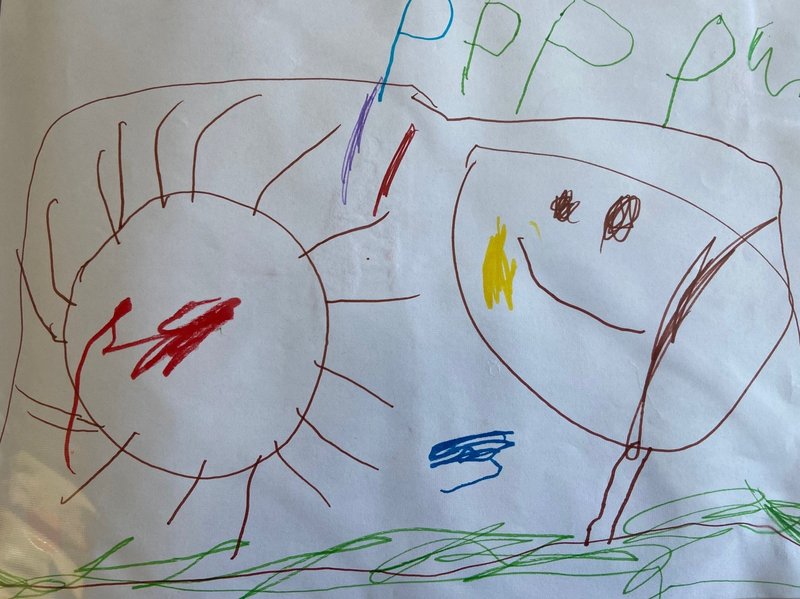There is no set answer to this question, all children are different. They will be ready to begin to learn to write their name at different ages, and that’s okay!
How to teach a child to write their name
Teaching children to write their name starts a long time before they actually have a go at forming the letter shapes. We've broken it down into three stages below to help you support your child as they learn to write their name.
Step one: Develop pre-writing skills
Support your child to develop an understanding of the link between speaking and writing:
- When you read a story together, point to the words as you say them.
- Notice and read signs when you’re out and about together.
- Explain that you’re reading, for example, when you follow instructions in a recipe or on a food packet.
- Help your child begin to recognise their own name and it’s importance; maybe make a sign for their bedroom door, show them as you sign their name in a birthday card or label their clothes for nursery.

Help your child develop the muscles and coordination they need to write:
- To develop gross motor skills: Provide lots of physical play activities, such as climbing, swinging, and ball play.
- To develop fine motor skills: Provide play activities which use hands and fingers, such as playdough, construction sets and jigsaws.

Build your child’s confidence and enjoyment in making marks and drawing:
- Provide opportunities for your child to use different types of tools for drawing and making marks: pens, pencils, crayons, chalk, paint, or even a stick in mud. If possible, make some of these available for your child to use when they choose. Chunky crayons and pencils are good to start with as they are easier to hold, and felt pens will enable your child to make more satisfying marks than a pencil.
- Ask your child to tell you about their drawings and offer to write their name on them.
- Give them lots of positive feedback to encourage all their attempts at drawing and writing.


Step two: Encourage drawing and early writing
If you give your child lots of the experiences above, some (not all) will become interested in writing their name independently. They may have a go at writing their name, or other words, in emergent (play) writing. If they do, give them lots of encouragement to continue practicing writing in this way. Don’t worry if it looks more like a squiggle than their name! For those that don't, keep providing lots of different opportunities for drawing and mark-making and continue to praise and encourage them.
Remember, all children are different. They will be ready to begin to learn to write at different ages, that’s okay!


Step three: Introduce name writing
You could start to introduce name writing to your child when they are:
- comfortable using a pen or pencil for drawing small marks, such as lines and circles,
- using drawing to represent real things, such as people,
- and are interested in their name.
If your child attends childcare or school, talk to their key person or teacher first to find out strategies they are using, and whether they think your child is ready.
Learning to write their name:
- Write your child’s name for them to copy, talk about the shapes, and sounds the letters make as you write the letters, and invite them to copy you one letter at a time.
- Start with just the first letter.
- Make sure you use a capital for the first letter only.
- Praise your child’s attempts to write the letters… it will take lots of practice to get it right!
- Once they start school you could ask if the school has any handwriting guidance. It will help your child if you teach them in the same way as their teacher at school.


Tips to support your child with writing their name
- Some letters are much harder to form than others, don’t worry if your child chooses to leave out some of the tricky ones to begin with.
- Writing your name for a purpose makes a lot more sense than just practicing writing your name, so encourage your child to sign birthday cards and pictures.
- Try not to compare your child with others, or pressure yourself or them, there is no requirement for children to write their name before they start school.
- Continue to encourage free drawing and the other activities in Steps one and two, as this is a good way for your child to express themselves through the marks they make.
- Writing in reverse, for letters such as b and d are very common, even up to the age of 7, so don’t worry.
- As children’s muscle control develops, the way they hold a pencil will change from using their whole fist to a tripod grip, for some children this may not happen until they are 5 or 6-years-old.
- To help you understand how tricky learning to write is for your child, have a go at writing with your non-dominant hand!
Remember... the activities in steps one and two are the most important things you can do to help your child learn to write!




